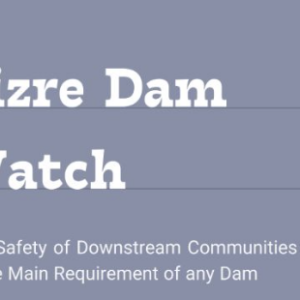The city of Basra, which went through a water crisis that successive governments failed to find solutions to, which made it the main demand that the summer 2018 demonstrations called for. Today, Basra is a disaster-stricken city due to the high salinity levels of Shatt al-Arab water, due to which at least 118 thousand people entered hospitals suffering from symptoms related to the quality of drinking water, due to toxic metals in sewage water, agricultural pollution and remnants of industrial companies, in addition to the salinity of the water.
Therefore, the series of online sessions organized by Humat Dijlah continue aiming to raise the environmental awareness and urging the environment-related authorities to address environmental problems, the association organized an Online Webinar entitled “The Water Crisis in Basra”, in January 7, 2022, to shed light on the most important reasons which led to the exacerbation of this crisis and the possibility of occurring same problems again in the coming years, and discussing how to prepare to confront it. As a number of environmental activists, government officials and those interested in the environment issues attended the session on the Zoom.
The webinar hosted the environmental expert, Dr. Shukri Al-Hassan, and the specialist in water resources, Dr. Wasan Sobeih Hamdan, where diagnosing the sources of water pollution in Iraq in general was the beginning, as Dr. Wasan mentioned that the waters of the Tigris and Euphrates are not subject to any proper environmental management or control processes, as most of the environmental laws are disabled and this in turn led to the most important sources of water pollution being human and uncontrolled, represented by household waste and sewage, in addition to the water of hospitals, laboratories, factories, farms and civil companies that built on the banks of the Tigris and Euphrates, as all of them are thrown in the two rivers, all the way to the Shatt al-Arab.
“The topographical slope of the area plays a role in the transfer of these pollutants, because the area of the Mesopotamian basin tends to decrease and flatten as we head to the south, so the process of water flow in this area is slow compared to the heights of the basin area, and this contributes to the concentration of pollutants at the end of the basin represented by the southern governorates, and Shatt al-Arab. Consequently, the pollutants take enough time to interact with the elements of the environment, such as soil, water, and the animals there.” Dr. Wasn explained.
As for the sources of water pollution in Basra in particular, Dr. Al-Hassan said that the quality of Basra water is affected by two sources of pollutants, one of which is represented by sewage that is collected from the rest of the provinces and pours into the center of Basra city in huge quantities that are discharged, on daily basis, to Shatt al-Arab, and the other is represented by agricultural drainage water that descends from the General Estuary in addition to the Iranian drainage water. Al-Hassan also indicates the less important sources such as industrial waste produced by industrial and oil facilities and power plants.
Al-Hassan mentioned that these pollutants are one of the reasons for the increase in saline concentrations in Shatt al-Arab, saying “The salinity of the water in Shatt al-Arab is due to two sources, the human source represented by sewage, and industrial water, as all of them form saline complexes that raise the salinity rate. And the natural source of sea water that penetrates into Shatt al-Arab during the tide and both of them make this water unfit for drinking or use”
On the same matter Dr. Wassan stated “We have noticed a difference in the characteristics of Shatt al-Arab water in recent years compared to the old studies and researches, by doing periodic studies on the plants and fish of Shatt al-Arab, as there is an increase in the concentrations of the main natural elements and heavy elements values; scientifically this means there is an increase in the pollution!”
Regarding the causes of Shatt al-Arab’s characteristics differences, Al-Hassan explained that these differences are due to the decrease in the water levels of Shatt al-Arab and the decrease in the water imports of the Tigris and Euphrates rivers, and thus sea water dominated in Shatt al-Arab as the fresh water is unable to push these salts, to solve this issues “We need to maintain the flow of water in Shatt al-Arab at a rate of 120 m3/s in order to be able to push the salts and confront the salinity of the water,” Al-Hassan said.
Speaking about the disaster that Basra experienced in the summer of 2018, Al-Hassan explained that the conditions that led to the poisoning crisis at that time were represented by the drop in the water levels in Shatt al-Arab due to the water policy of neighboring countries, such as the lack of water imports from Turkey, and Iran’s relentless efforts to change the path of the rivers that feed Shatt al-Arab mainly such as the Karkheh and Karun rivers, in addition to the severe drought and the lack of rains that reinforced the poor water situation, which led to the penetration of sea water into Shatt al-Arab in large quantities and over long distances, in addition to the accumulation of pollutants that were dumped in Shatt al-Arab, And without the abundant rains in 2019 that were able to push these salts, we would not have been able to cross this problem, Al-Hassan draw the attention saying “The experience was almost repeated last year, but public pressure made the central government release quantities of stored water in order to push off salinity.”
In answer to the question, “Will Basra suffer from a salinity crisis in the future?” Al-Hassan said that government agencies are not interested in working to reduce pollutants that are dumped into rivers, or working to find a way to stop the penetration of sea water into the Shatt al-Arab, If the same reasons meet again, Basra will inevitably suffer from this crisis again, and then we will not have a water reservoir to deal with the situation.
Regarding the location of Basra amid the climate change that the world is facing, Al-Hassan said “scientists expecting temperatures to rise by 2.5 degrees, the impact in Basra, according to some studies, will be 7 times higher than the global levels [because] Basra is located in an environmentally fragile region, much more sensitive to climate changes, and this means more drought, desertification, dust storms, and more salinity due to rise of sea levels as a result of melting ice, as Basra’s location is in a low-lying area that allows greater penetration of sea water”
Referring to measures taken by the environment-related authorities to confront those problems, Dr. Wasan said, “There are no serious measures taken so far, but there are projects for desalination stations and projects to increase water levels, but they are not at the required level. Those authorities must negotiate with upstream countries to increase water releases. They must also establish strict laws to protect water and the environment in all Iraqi governorates.
The experience of 2018 was tragic for the residents of Basra. If the local and central governments continue in this way and do not work to address the situation, things will get worse and we will not be ready to face this experience if it is repeated in the future” Dr. Wasan said.
As for the impact of this crisis on the economic side of Basra, Dr. Wasan pointed that the scarcity of water and its salinity have contributed to reducing the proportion of agricultural lands, as salinity, pollution and water scarcity, lack of rain, oil pollution and acid rain led farmers to leave their lands because [their lands] became unsuitable for agriculture, “The impact of this crisis affected the biodiversity in the region, Many waterfowl and fish in Shatt al-Arab and the marshes have migrated because the characteristics of the waters have become unsuitable for their livelihood, and undoubtedly this has an economic impact on fisheries” Wassan said
On the social impact, Dr. Shukri said, “Most of the tribal conflicts are rooted to water scarcity, especially in southern Iraq and Basra, and the increase in the immigrants number who came to escape from areas facing water scarcity to the center of Basra causes destabilization and social insecurity”
In this regard, one of the attendees mentioned that reviving the marshes in light of the current water scarcity crisis and drought expectations for the upcoming years is ‘wasting water resources,’ since the marshes are temporary water sites and it is better to store and utilize this water within rivers and lakes, But Dr. Alaa Al-Badran, an environmental expert who was one of the attendees too, explained that the marshes have a great importance at all levels, saying “The marshes have great economic importance, as the diverse and large fish stocks in them represent job opportunities for more than 30,000 fishermen in the southern governorates, and they are an ideal solution instead of the establishment of fish ponds that salinize the soil, and they also have a lot of reed and papyrus plants, which have become pastoral plants that benefit buffalo breeders a lot, and thus increase the production of meat, milk and its derivatives.”, Al-Badran expressed “It is no secret that the marshes are an environment for a large number of the population who, if we are supposed to drain the marshes, will have to migrate into the cities, and this means more conflicts and insecurity”
The webinar then progressed to the role of researchers in finding and diagnosing realistic solutions to reduce the crisis, Dr. Wasan condemned the current relationship between the authorities and researchers saying “We as researchers and academics have many researches, studies and points of view, which if they meet will find a solution to Basra’s suffering, but there is a gap between the executive side and the researchers” Adding “If the related authorities seek to take real measures, they should use the researchers’ expertise instead of foreign companies”
Regarding the role that civil society can take in solving environmental problems, Al-Hassan explained, “The government is unable to adopt projects that would face the environmental situation, as environmental solutions need to implement a stable political system and long-term strategic planning, and this is what we don’t have in Iraq, but the role of people, organizations and society can solve this crisis through training and rehabilitating people on how to face environmental crises and programs that civil society organizations can adopt to prepare ourselves in facing the climate change crisis and how to deal with the salinity crisis if it recurs.”
On the other hand, Dr. Wassan had a different opinion, as she said, “It is certain that individuals can contribute to solving the problem, and we have a research in this aspect. We need awareness campaigns for people to be aware of Basra’s suffering. I also commend the youthful energies that are trying to create a positive change in their environment by cleaning campaigns, afforestation campaigns, awareness-raising campaigns and others, but the issue is greater than these energies! The work of organizations must be supported by government agencies, by imposing punishments on transgressors starting by controlling government sectors first, working to activate environmental laws, reaching agreements with upstream countries and working on proper water management.” She added, “Social studies exist and we can activate the role of the community more, but practical and realistic solutions also exist, they only need government implementation”
This webinar is part of a series of online sessions organized by Humat Dijlah Association to shed light on issues related to the environment and water reality of the cities of the Tigris and Euphrates rivers through the use of online platforms.
To Watch The Entire Webinar on YouTube HERE.




Leave a Reply